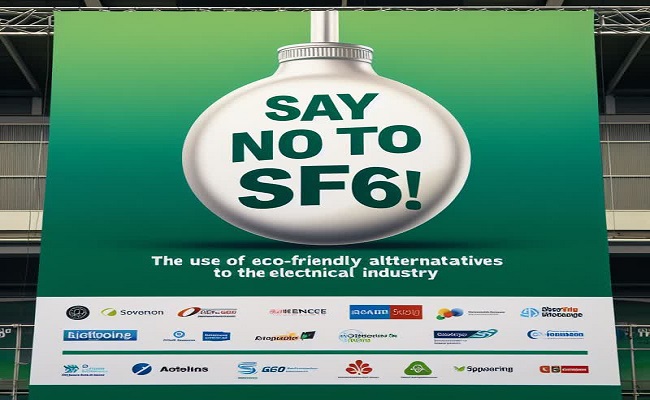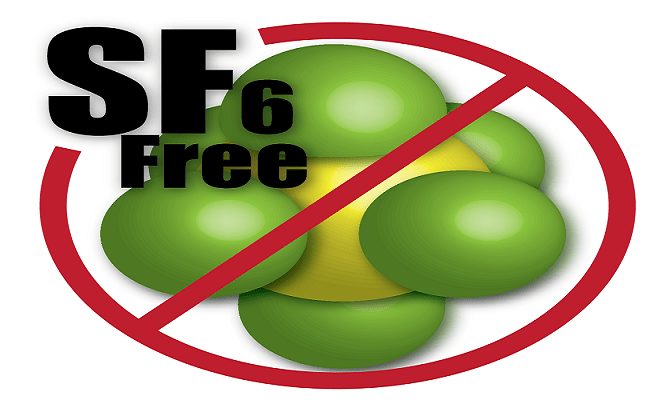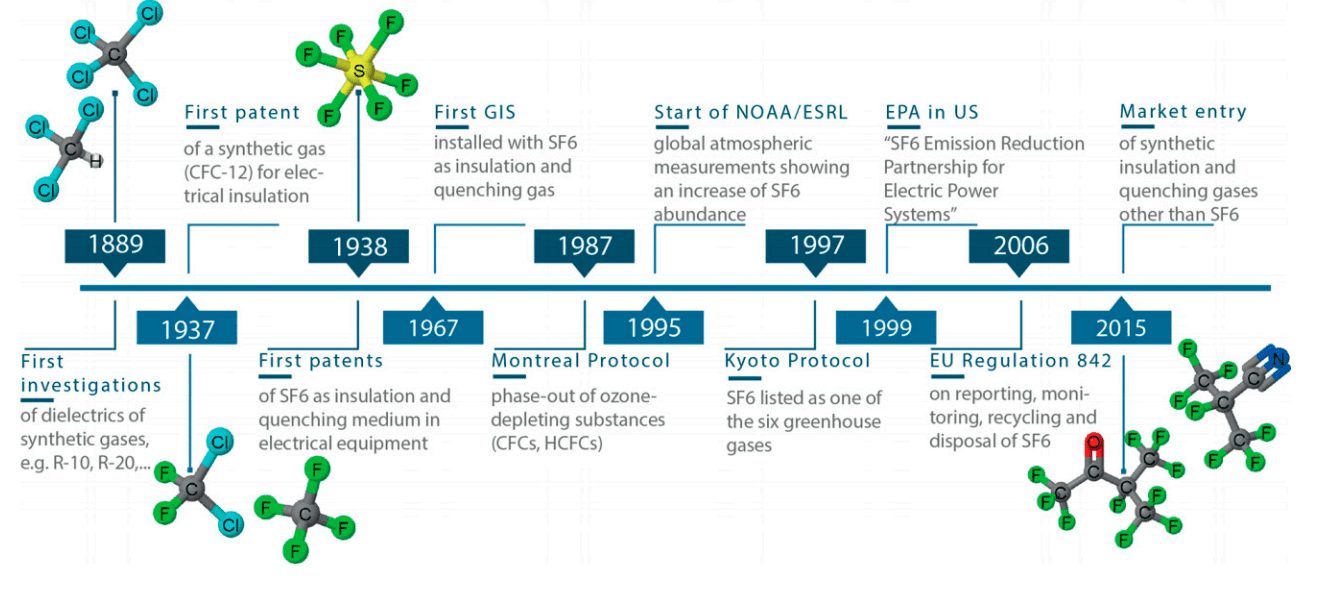
Most of these articles about SF6 Free Switchgear have been presented at prestigious international conferences and have been published in scientific journals.
The source and authors of the articles are mentioned at the bottom of each article.
- Article No. 1:
Analysis of long-term effects during the development of SF6-free gas-insulated switchgear
Publisher: IET
Abstract:
An essential evaluation criterion in the design of SF6-free switchgear is long-term reliability, which is evaluated by a combination of approx. 40 years of experience with gas-insulated switchgear and the simulation of long-term effects. Long-term effects such as the aging of certain material types induced by the insulating gas can be caused by a combination of chemical, thermal, mechanical, and electrical processes. In the early phase of product development such effects were addressed by selecting suitable materials and manufacturing technologies. Furthermore, material and gas aging tests (up to 5,000 hours) were conducted to ensure compatibility. Early pilots confirm the development results. In this way, the initial experience of handling grid operations could also be gained. In this paper, the authors discuss how the combination of aging tests, simulation models, and an insightful pilot phase has made it possible to ensure a reliable and long-term operation of F-gas-free solutions in the grid.
Published in: 27th International Conference on Electricity Distribution (CIRED 2023)
Date of Conference: 12-15 June 2023
DOI: 10.1049/icp.2023.1106
Authours: A. Kalter; D. Becht; K. Esser-Rank; P. Halbach; T. Hammer; H. Haupt; B. Woelke (Siemens AG, Germany)

- Article No. 2:
Comparative Life Cycle Assessment of SF6-based SP-3 and SF6-free Eco 145kV Gas Insulated Switchgear
Publisher: IEEE
Abstract:
This paper presents the results of a life cycle assessment (LCA) of two variants of a 145kV high voltage circuit breaker (HVCB) gas-insulated switchgear (GIS) substation: (i) SF 6 -based SP-3, and (ii) SF6-free Eco, which uses the eco-friendly fluoronitriles-based Novec 4710 synthetic gas mixture. The ReCiPe2016 midpoint-oriented calculation methodology is used, which provides life cycle impact assessment results in terms of 18 environmental impact indicators, that are then grouped into four life cycle stages; production, transportation, use, and end-of-life. First, an LCA of both variants is performed. Next, a comparative LCA of the SF6-based and SF6-free HVCB GIS is conducted, followed by an interpretation of the results considering the most influential parameters. The results indicate that adopting the SF6-free Eco variant has a significant positive impact on global warming potential, a key climate change indicator. Finally, the characteristic features of the LCA are summarized along with recommendations for future strategy and improvement.
Published in: 2023 IEEE PES Grid Edge Technologies Conference & Exposition (Grid Edge)
Date of Conference: 10-13 April 2023
INSPEC Accession Number: 22961483
DOI: 10.1109/GridEdge54130.2023.10102710
Authors: Kedar S. Pandya; Manuel Gotti; Javier Mantilla (Hyundai Electric Switzerland)
- Article No. 3:
Life-expectance evaluation for SF6-free switchgear using C4-FN mixtures
Publisher: IET
Abstract:
In switchgear utilizing C4-FN mixtures as a replacement for SF6, two of the main factors that require in-depth analysis to ensure proper life expectancy are: (a) leakage and (b) decomposition from switching. Leakage can be due to gross leaks or permeation through gaskets. A novel methodology is presented to evaluate leakage around gaskets (rubber seals) for both static and dynamic applications, to assist material selection. The consequences of gas permeation are also estimated for 3 different geographical locations. Finally, C4-FN decomposition caused by switching is calculated based on the arcing energy and compared with the FTIR gas analysis of the mixture before and after switching. Results are presented along with recommendations to reduce pitfalls in the design of gaskets for C4-FN applications.
Published in: 27th International Conference on Electricity Distribution (CIRED 2023)
Date of Conference: 12-15 June 2023
Electronic ISBN:978-1-83953-855-1
DOI: 10.1049/icp.2023.0470
Authors: A. Laso; I. Mainwaring; T. Yeaton; K. Mann; K. Darko; N. Uzelac (G&W Electric, USA)
- Article No. 4:
Avoiding uncertainties on safety and reliability in 24 kv SF6 free secondary distribution switchgear
Publisher: IET
Abstract:
Now that a new proposal for a regulation on fluorinated gases has been released in the European Union, a relevant technological change should be managed in an extremely short period. As a reference, the technological change from air to SF6 in medium voltage took almost two decades (even counting on the former experience of high voltage), and now it is assumed this new change will be done within three years. Focusing on the switchgear for 24 kV in public secondary distribution networks, there are some millions of them in service, with non-intensive maintenance and placed, in many cases, in public concurrence locations, and sometimes in extreme and very diverse environmental conditions.
Published in: 27th International Conference on Electricity Distribution (CIRED 2023)
Date of Conference: 12-15 June 2023
Date Added to IEEE Xplore: 29 September 2023
DOI: 10.1049/icp.2023.1226
Authors: J. M. Inchausti; J. Arostegui; S. Sebastian (Ormazabal, Spain)

- Article No. 5:
Development of an SF6-free AC HV Dead-Tank Circuit Breaker Rated 145 kV, 63 kA
Publisher: IEEE
Abstract:
Design and verification testing performed during the development of a mixed gas-insulated AC HV dead-tank power circuit breaker rated 145kV,63kA,4000 A, and 60 Hz are described. The circuit breaker utilizes a mixture consisting of carbon dioxide (CO2), oxygen (O2), and fluoronitrile (C4−FN) gases. The development of this breaker required the adaptation of existing gas-insulated technology to the interrupting and insulating characteristics of this gas mixture. The gas mass in the circuit breaker is 40% of that of an SF 6 -insulated breaker and the GWP of the gas mixture is 1.3% of SF 6 GWP. Braking tests were performed under terminal, transformer limited, short-line, and out-of-phase fault conditions. Breaking service capability was also demonstrated. Capacitive switching tests were performed for a C2 Class with a voltage factor of 1.7. Dielectric tests included power frequency withstand, BIL, chopped wave, and AC withstand at atmospheric pressure. Mechanical endurance tests achieved M2 class with 10,000 operations. Current carrying capability tests were performed at 3000 and 4000 A. The circuit breaker’s main current path resistance was in new condition and after reaching the electrical endurance was stable. This technology demonstrated similar performance to SF6 with nearly the same material content, and dimensional characteristics, and without requiring excessive operating pressure. Material content has significant implications for the equipment’s climate change impact, compensating for the favorable emission impact of competing technologies using technical air insulation with zero GWP.
Published in: 2023 IEEE Power & Energy Society General Meeting (PESGM)
Date of Conference: 16-20 July 2023
DOI: 10.1109/PESGM52003.2023.10252711
Authors: Victor F. Hermosillo; Matthias Schirmer; Todd Irwin; Ludovic Darles; Cyril Gregoire (GE Grid Solutions)



